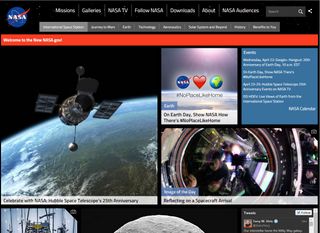
NASA's Website Just Got a New Look

Houston, we have a new website. Today, NASA launched a major redesign of their homepage, and the new product puts heavy emphasis on images and connection with social media.
The new look of www.nasa.gov is a striking departure from the old design — most noticeable is the overwhelming presence of images, which take up more than half of the front page. The website's overall organization has also undergone some changes, and there are some modifications to the categories, topics and sections.
"Based on extensive user feedback and testing, we've modernized NASA.gov to work across all devices and screen sizes, eliminate visual clutter, and put the focus on the continuous flow of news updates, images and videos we know you're looking for," NASA said in a statement.
If users get lost while navigating the new website, they'll stumble upon a unique 404 page that reads, "The cosmic object you are looking for has disappeared beyond the event horizon."
While the new website appears overwhelmed with photos and videos compared to the old design, NASA's statement about the redesign states that "one of the top user complaints about the site has been the difficulty in navigating the visual clutter."
"The new design has far fewer links per page, and the focal point is a dynamic feed of content, arranged largely in reverse chronological order, and incorporating feature stories, images and videos," the statement said.

In addition, the new site will link related topics and stories on the same page. "Once you've clicked on a piece of content, we present an 'infinite scroll' of related content. As long as you scroll down the page, you'll be presented with recent stories or images on that topic."
Get the Space.com Newsletter
Breaking space news, the latest updates on rocket launches, skywatching events and more!
The redesign also focused on making it easier for visitors to share content via social media, and making the site friendlier to different devices. NASA stated that "over 25% of our audience is now coming to the site on a phone or tablet."
Follow Calla Cofield @callacofield. Follow us @Spacedotcom, Facebook and Google+. Original article on Space.com.
Join our Space Forums to keep talking space on the latest missions, night sky and more! And if you have a news tip, correction or comment, let us know at: community@space.com.

Calla Cofield joined Space.com's crew in October 2014. She enjoys writing about black holes, exploding stars, ripples in space-time, science in comic books, and all the mysteries of the cosmos. Prior to joining Space.com Calla worked as a freelance writer, with her work appearing in APS News, Symmetry magazine, Scientific American, Nature News, Physics World, and others. From 2010 to 2014 she was a producer for The Physics Central Podcast. Previously, Calla worked at the American Museum of Natural History in New York City (hands down the best office building ever) and SLAC National Accelerator Laboratory in California. Calla studied physics at the University of Massachusetts, Amherst and is originally from Sandy, Utah. In 2018, Calla left Space.com to join NASA's Jet Propulsion Laboratory media team where she oversees astronomy, physics, exoplanets and the Cold Atom Lab mission. She has been underground at three of the largest particle accelerators in the world and would really like to know what the heck dark matter is. Contact Calla via: E-Mail – Twitter
